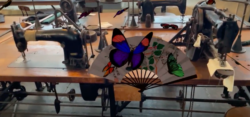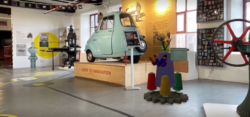A Human Perspective (May 2022)
Hello, and welcome back to the Song future blog!
This week we continue our spotlight series on the major players in the upcoming performance, this time turning to the digital partners that will bring the experience to life. Today, I will be talking to Nick Bax, creative director of Human - the creative agency behind the striking visuals featured in Song of the Female Textile Worker, and ongoing collaborator for the Song future project - about his time with the project thus far, how it has helped build connectivity between the UK and China, and how he hopes to see the project develop in the future.
Humanstudio (or simply Human) are a Sheffield-based creative agency working in animation, virtual reality, performance and beyond. Founded in 2007, they have built up an extensive portfolio of work, collaborating with academics, artists and brands from around the world. From exhibitions of 3D printed models in Tokyo, to branding and animations for record labels and DJs in the USA, to many projects closer to home here in the UK, Human is dedicated to pushing technological boundaries to develop new and engaging experiences, both online and in live events. Human works closely with their partners in order to understand how best to present their visions and culture, such that they may share them with a wider audience.
Though their projects may share common threads in their use of immersive environments and bespoke elements, they are more commonly united by how different and unique each feels. Indeed, Nick explains that this constant state of innovation and experimentation is a key driving factor in every project that Human undertakes. Even when setting out with a vision of what is to come, he believes that there should always be plenty of 'wiggle room' to manoeuvre, and test out new and different ideas.
As he puts it, if he can already imagine the output when the project is just starting out, then what is the point of doing it?
It was with this spirit of connectivity and ingenuity that they joined the original Song of the Female Textile Worker project, sharing vision of Dr. Haili Ma, Principal Investigator of the project that the UK and China's hitherto unexplored cultural similarities could be explored through the medium of digital performance. The group played a pivotal role in the original performance, with Human - and in particular Abby Hambleton, the lead on the digital creation - responsible for designing and creating the striking visualisations used throughout that brought the show to life. Bright visuals of butterflies fluttering across the stage, ribbons and sleeves sweeping and intertwining, threads and flowers dancing and weaving - all were only possible thanks to the team at Human.

Human's butterfly animations as seen in film Song of the Female Textile Worker
Nick ruminates for a moment on this choice of objects. He recounts that though their symbolism might be different in the British and Chinese cultures, their visual impact and peoples' reaction to them remained in both territories. I found this particularly interesting, as it answered capably one of the research project's core questions, demonstrating that such a digital performance could indeed resonate with audiences in both the UK and China, despite their cultural differences.
The execution of the project wasn't always straightforward, however, and one particularly novel concern was constantly present throughout; that of how to conduct and develop international collaboration during a global pandemic. Once upon a time, Human would have worked together in person with their colleagues at the Shanghai Yue Opera House, capturing sound and motion together to craft the final show. Alas, this was not possible at the time due to on-going travel restrictions. Instead, they had to rely, as so many of us did, on long-distance zoom calls, and impersonal emails to relay ideas and information.
Nick tells me that this was something of an eye-opening experience for Human. Although they've always been fascinated by the differences in the way people work - and, moreover, by the surprising amount of commonality to be found therein - it became much more obvious when half a world separated the collaborators.
Something that to one individual seemed almost trivial - establishing a proper recording setup, for example - would be completely alien to another. Suggestions or ideas that someone might casually offer during a lunch or coffee break might never see the light of day. Everyone has a different focus, and different strengths and weaknesses; the performer hones their act, but pays less attention to the displays behind them; the cameraman will work tirelessly to get the balance of lighting perfect, but has little impact on the routine's dance moves, and so forth.
It reinforced that working as a larger group, with a wide variety of available skills, is to the benefit of all involved. This again resonates with the core aspirations of the Song of the Female Textile Workers project; that collaboration between the UK and China in digital performance could aid UK creative industries' inroads into the Chinese market, and provide essential bridges between the two groups.
With the upcoming Song future performance, Human is looking to build on what they achieved in the first part of the project, by bringing the iconic imagery of the red flowers, woven twine, fluttering butterflies and more into the world of Armley Mills using augmented reality (AR) [1].
Indeed, it will be their first foray into AR in a museum environment, and Nick is enthusiastic about potential innovations that this could bring. He dreams of being able to overlay information onto exhibits and machinery in an intuitive and thought-provoking way, and using it to tell stories that might otherwise be lost. Again, the history of the Jacquard loom and its importance as one of the progenitors of modern data storage comes up in particular.

In many ways, his comments echo those of the Leeds Industrial Museum team from last week, and indeed the overall goals of the project; that by utilising these new technologies the museum hopes to find inroads into new demographics, and engaging with everyone in novel, exciting ways. But it's not just the new setting: the interactivity of the Song future performance is also something of a novelty to the Human team. One of the main aims of the project is to collect stories of the textile industry in the Leeds region, and its evolution into the creative industries that now flourish both here and in China, and as such the experience created for it must be engaging, and encourage this discussion. Nick admits that doing this alone would not be easy, but that in working closely with their friends and colleagues at Megaverse - the interactive studio that will be building the Song future experience itself - they hope to share and learn from each other's expertise to create a captivating and memorable experience.
Of course, there will be challenges along the way. Nick acknowledges that in utilising emerging technology they are likely to be teething problems, and that there may be as yet unforeseen issues in the international collaboration with China as a whole. For his part, Nick remains confident that with Human's extensive experience and ingenuity, they will be able to overcome any such obstacles.Indeed, these emerging difficulties are another aspect that the Song future project itself is keen to identify, in the hope that future China-UK collaboration can be more readily facilitated using the lessons that we learn here.

Whilst the completion of the current performance in both the UK and China is rightly foremost in his mind, Nick is also keeping half an eye on possible extensions of the project into the longer term future. With wearable AR devices just around the corner - think Google Glass, but more powerful, better resolution, and more affordable - the possibilities for performances such as the Song future project can only expand greatly.
Imagine, if you will, walking through a museum or gallery, with a personal guide walking beside you, talking, singing, or even dancing, and highlighting information that you can see popping up beside and through the exhibits. It might sound like the work of science fiction right now, but it's not too far off in the future, and the likes of Human are looking to be right at the vanguard of its inception.
Ultimately, it is Nick's hope that at some point this sort of experience becomes commonplace, and that someone, somewhere, might, during such an event, turn to their partner and ask; 'hey, doesn't this remind you of that exhibition in Armley, or Shanghai M50?'
I, for one, cannot wait to see what they can create.
For more information on Human, visit their website at humanstudio.com.
Footnote:
[1] Using technology to overlay graphics or information onto images of the real world, in real time.
